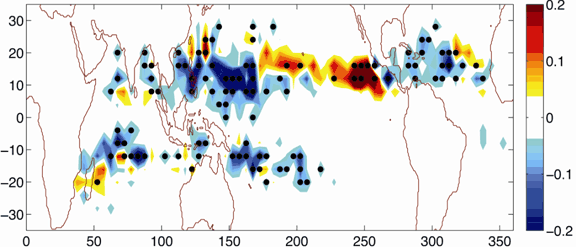February 3rd, 2012
Key Findings
- A large source of uncertainty in future projections of basin-wide hurricane activity is found to be the inter-model variation in the projected sea surface temperature (SST) warming pattern.
- In the N. Atlantic, E. Pacific and S. Indian basins, most of the variance in future hurricane projection can be explained by changes in a simple relative SST index, defined as a basin’s storm development region SST minus the tropical mean SST.
- A simple measure of overall convective activity stands out as an atmospheric parameter that is skillful in explaining the simulated differences among climate models.
- Globally, the simulations exhibit a small but robust eastward and poleward migration of genesis frequency in the N. Pacific and the N. Atlantic in response to 21st century warming.
Ming Zhao and Isaac Held. TC-permitting GCM simulations of hurricane frequency response to sea surface temperature anomalies projected for the late 21st century. Journal: J. Climate. doi: 10.1175/JCLI-D-11-00313.1
Summary
One aspect of uncertainty in future projections of basin-wide hurricane activity stems from the variety of projections of the spatial pattern of tropical warming. A high-resolution, global atmospheric model is used to explore hurricane frequency response to sea surface temperature (SST) anomalies generated by coupled models for the late 21st century using the SRES A1B scenario.
In the N. Atlantic, the E. Pacific and the S. Indian basins, most (70-85%) of the inter-model variance in hurricane frequency response to 21st century warming projected by coupled climate models can be explained by a simple relative SST index defined as a basin’s storm development region SST minus the tropical mean SST. The implication is that the key ingredient in predicting future Atlantic hurricane activity in particular, is to reduce the uncertainty in our prediction of warming of the Atlantic, with respect to the rest of the tropics.
The explained variance is significantly lower in the S. Pacific (about 50%) and much lower in the W. Pacific basin. When the W. Pacific is separated into 3 sub-basins, 42% of the inter-model variance in the main development region can still be accounted for by the simple relative SST index while storms in South China Sea and the Eastern W. Pacific correlate to SSTs in the Central and Eastern Pacific.
Several atmospheric parameters are utilized to probe changes in tropical atmospheric circulation and thermodynamical properties relevant to storm genesis. While all present strong correlation to storm frequency response in some of the basins, a parameter measuring tropospheric convective mass flux stands out as skillful in explaining the simulated differences for all basins.
Globally, in addition to a modest reduction of total storm frequency, the simulations exhibit a small but robust eastward and poleward migration of genesis frequency in both the N. Pacific and the N. Atlantic oceans upon warming. This eastward migration of storms can also be explained by changes in convective mass flux.
Geographical distribution of changes in annual hurricane genesis frequency

Color: average from 8 individual models’ SST anomaly experiments
Stipple: area where 6 out of the 8 models agree on the sign of change
Unit: #/year/4°x5°


